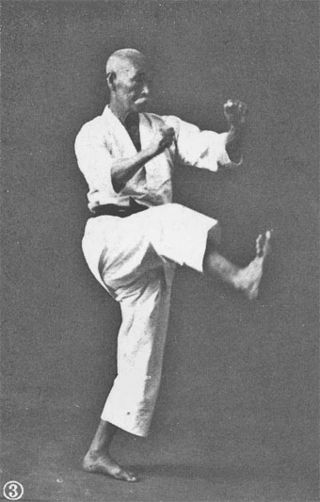
Karate (空手), also karate-do, is a martial art developed in the Ryukyu Kingdom. It developed from the indigenous Ryukyuan martial arts under the influence of Chinese martial arts, particularly Fujian White Crane. Karate is now predominantly a striking art using punching, kicking, knee strikes, elbow strikes, and open-hand techniques such as knife-hands, spear-hands, and palm-heel strikes. Historically, and in some modern styles, grappling, throws, joint locks, restraints, and vital-point strikes are also taught. A karate practitioner is called a karate-ka (空手家).
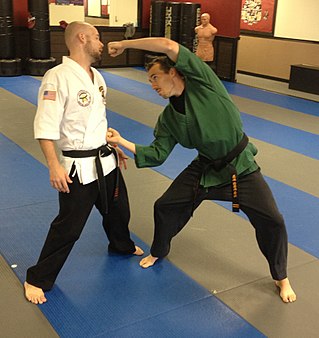
Kenpō is the name of several arts. The word kenpō is a Japanese translation of the Chinese word "quánfǎ" which literally just means "fist method" or "striking method". This term is often informally transliterated as "kempo", as a result of applying Traditional Hepburn romanization, but failing to use a macron to indicate the long vowel. The word Kenpō translates thus: "Ken" meaning 'Fist' and "Po" meaning 'Method' or 'Law' as in 'Law of gravity', a correct interpretation of the word Kenpō would be 'Fist Method', the same meaning as 'Quanfa'. However, it is often misinterpreted as 'the Law of the Fist'. The generic nature of the term combined with its widespread, cross-cultural adoption in the martial arts community has led to many divergent definitions.
Kajukenbo is a hybrid martial art from Hawaii. It was developed in the late 1940s and founded in 1947 in the Palama Settlement on Oahu, Territory of Hawaii.
Shorinji Kempo is a Japanese martial art claimed to be a modified version of Shaolin Kung Fu. The name Shōrinji Kempo is the Japanese reading of Shàolínsì Quánfǎ. It was established in 1947 by Doshin So [born Michiomi Nakano], a Japanese martial artist and former military intelligence agent who lived in China for many years before and during World War II.

American Kenpo Karate, also known as American Kenpo or Ed Parker's Kenpo Karate, is an American hybrid martial art, founded and codified by Ed Parker. It is synthesized mainly from Japanese and Okinawan martial arts such as karate, kenpo, and judo, with influence from Chinese martial arts.

Shōrin-ryū (少林流) is one of the major modern Okinawan martial arts and is one of the oldest styles of karate. It was named by Choshin Chibana in 1933, but the system itself is much older. The characters 少林, meaning "sparse" or "scanty" and "forest" respectively and pronounced "shōrin" in Japanese, are also used in the Chinese and Japanese words for Shaolin. "Ryū" means "school". Shōrin-ryū combines elements of the traditional Okinawan fighting styles of Shuri-te.

Shōrinjiryū Kenkōkan Karate (少林寺流拳行館唐手) is a style of karate founded by Kōri Hisataka (1907–1988) shortly after World War II in Japan.
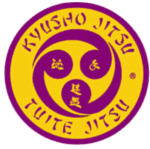
Ryu-te is an Okinawan martial art founded by the late Seiyu Oyata (1928–2012). The word Ryū-te is a shortened form of Ryūkyūte. Ryukyu is the original name of Okinawa prior to it becoming part of Japan. Before 1995, Oyata referred to his style as Ryukyu Kempo (琉球拳法), but eventually renamed it "Ryu-te" as Ryukyu Kempo was a reference to all styles originating in Okinawa rather than to any one particular style. Ryu-te emphasizes effective self-defense while deliberately minimizing the harm to the opponent. Its practitioners consider Ryu-te neither a sport nor a form of exercise, but rather a method of training the body and mind for the betterment of mankind.

Tang Soo Do is a Korean martial art based on karate and may include fighting principles from taekkyeon, subak, as well as northern Chinese martial arts. From its beginnings in 1944 to today, Tang Soo Do is used by some Kwans to identify the traditional Korean fusion of martial arts styles. In the mid 1950s, Tang Soo Do became the basis for the martial art Taekwondo when the Korean Nine Kwans united.

Sin Moo Hapkido is a martial art that combines "hard" and "soft" techniques. From a purely technical perspective, it is very closely related to its parent art, Traditional Hapkido, though it places more emphasis on meditative, philosophical, and Ki development training. Hapkido is often translated as “the way of coordinating power,” which places emphasis on the physical techniques that Hapkido is often known for. However, the founder of Sin Moo Hapkido, Ji Han-jae, has landed on a different understanding of the term. Hap means bringing together, gathering, or harmonizing. “Ki” is the energy or breath in the body that connects the mind and the body, and "Do" is the process or way this happens. Thus, his definition of Hapkido is, “The way of harmonizing the mind and body through the utilization of ki.” Sin means "higher mind or higher spirit," and "Moo" means "martial art."
The karate kataSeisan (十三) literally means '13'. Some people refer to the kata as '13 Hands', '13 Fists', '13 Techniques', '13 Steps' or even '13 killing positions'; however, these names have no historical basis.

Chitō-ryū (千唐流) is a style of karate founded by Dr. Tsuyoshi Chitose, (1898-1984). The name of the style translates as: chi (千) - 1,000; tō (唐) - China; ryū (流) - style, school, "1,000 year old Chinese style." The character tō (唐) refers to the Tang dynasty of China. The style was officially founded in 1946.
The Korean terms hyeong, pumsae, poomsae and teul are all used to refer to martial arts forms that are typically used in Korean martial arts such as Taekwondo and Tang Soo Do.
Ryūkyū Kempo (琉球拳法) sometimes spelled Ryūkyū Kenpō is a generic term often used to describe all forms of karate from the Ryukyu Islands, and more specifically to refer to the particular styles associated with Taika Seiyu Oyata and George Dillman. Whereas, Kenpō is associated with the spelling of Master Nakamura's Okinawan Kenpō, Seikichi Odo's Ryūkyū Hon Kenpō, and D'veed Natan's Ryukyu Kenpo Kobujutsu. Oyata is credited with being the originator of the American use of the terms Ryukyu Kempo, tuite-jutsu and kyusho-jutsu. The name Ryūkyū Kempo was adopted by a prominent martial arts personality, George Dillman, who taught his own version of Oyata’s style and promoted it heavily through seminars and publications. This further prompted Oyata to change the name to Ryū-te and to change the curriculum of what he was teaching to reflect his own system of "Life Protection". The Ryū-te organization is international and includes a selection of long-time students known as "Oyata Shin Shu Ho," whom he considers the heirs of his art.
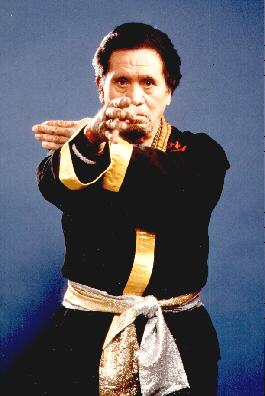
William Kwai-sun Chow was instrumental in the development of the martial arts in the United States, specifically the family of styles referred to as kenpo/kempo.
This martial arts timeline is designed to help describe the history of the martial arts in a linear fashion. Many of the articles for particular styles have discussions of their history. This article is designed to help visualize the development of these arts, to help better understand the progression of the separate styles and illustrate where they interrelate.
Adriano Directo Emperado was one of five martial artists who developed the kajukenbo self-defense system.

Shaolin Kenpo Karate is a martial art style that combines the Five Animals of Shaolin Kung Fu (Shaolinquan), the core competency of Kempo, the hard-hitting linear explosiveness of traditional Karate, as well as the power of Western boxing and the felling and grappling arts of Jujutsu, Chin Na, and Mongolian wrestling. This system was founded and developed by Fredrick J. Villari, who devised a hybrid system which integrated the four ways of fighting: striking, kicking, felling, and grappling to eliminate the inherent weakness of martial arts systems that focus on just one or two of fighting techniques.

Wudangquan is a class of Chinese martial arts. In contemporary China, Chinese martial arts styles are generally classified into two major groups: Wudang (Wutang), named after the Wudang Mountains; and Shaolin, named after the Shaolin Monastery. Whereas Shaolin includes many martial art styles, Wudangquan includes only a few arts that use the focused mind to control the body. This typically encompasses tai chi, xingyiquan and baguazhang, but must also include bajiquan and Wudang Sword. Although the name Wudang distinguishes the skills, theories and applications of the internal arts from those of the Shaolin styles, these arts did not originate in the Wudang Mountains: the name Wudang comes from a popular Chinese legend that purports the genesis of tai chi and Wudang Sword by an immortal, Taoist hermit named Zhang Sanfeng who lived in the monasteries of Wudang Mountain. Wudang quan is often used synonymously with Neijia, but Neijia is a broader term that also encompasses Aikido and Qigong, which are not Wudang quan.
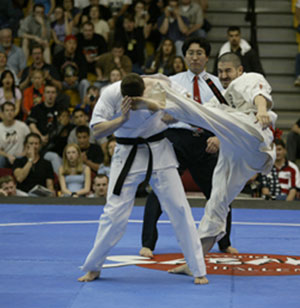
Karate was first introduced to American service men after World War II by Japanese and Okinawan karate masters.











